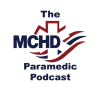Texas has been the epicenter of the ground-based EMS integration of whole blood programs for hemorrhagic shock in the prehospital setting. The MCHD clinical staff have been watching the evidence closely and feeling the push from our own medics.
In this episode of the MCHD Paramedic Podcast, join MCHD Medical Directors Dr. Dickson and Dr. Patrick as they discuss the “why” behind no whole blood at MCHD (yet).
The decision to incorporate whole blood touches on factors including:
- Area size
- Trauma surgery availability and level
- Blunt versus penetrating trauma ratio
- System size and transport times
The discussion includes:
- Research review
- Large volume crystalloid
- Plasma vs. saline
- Minimizing waste
- The blood shortage
- Transport times
- Costs
They also discuss whole blood alternatives, including:
Learn more:
Dr. Peter Antevy talks head-up CPR, whole blood use by EMS
In this episode, our co-hosts welcome back Dr. Peter Antevy who offers his thoughts on the direction the industry is heading and the up-and-coming hot topics
References
- Holcomb JB, et al, PROPPR Study Group. Transfusion of plasma, platelets, and red blood cells in a 1:1:1 vs a 1:1:2 ratio and mortality in patients with severe trauma: the PROPPR randomized clinical trial. JAMA. 2015 Feb 3;313(5)
- Stein et al. Reduction of massive transfusion in major trauma patients Anaesthesia 2017, 72, 1317–1326
- Pusateri AE, et al. Association of Prehospital Plasma Transfusion With Survival in Trauma Patients With Hemorrhagic Shock When Transport Times Are Longer Than 20 Minutes: A Post Hoc Analysis of the PAMPer and COMBAT Clinical Trials. JAMA Surg. 2020 Feb 1;155(2)
- Moore HB, et al. Plasma-first resuscitation to treat haemorrhagic shock during emergency ground transportation in an urban area: a randomised trial. Lancet. 2018 Jul 28;392(10144):283-291.
- Sperry JL, et all; PAMPer Study Group. Prehospital Plasma during Air Medical Transport in Trauma Patients at Risk for Hemorrhagic Shock. N Engl J Med. 2018 Jul 26;379(4):315-326.
- Guyette FX, et al. Prehospital Low Titer Group O Whole Blood Is Feasible And Safe: Results Of A Prospective Randomized Pilot Trial. J Trauma Acute Care Surg. 2022 Jan 25.
- Braverman MA, et al. Prehospital whole blood reduces early mortality in patients with hemorrhagic shock. Transfusion. 2021 Jul;61 Suppl 1:S15-S21.
- Sayre MR, et al. Providing whole blood for an urban paramedical ambulance system. Transfusion. 2022 Jan;62(1):82-86.
- Harmsen AM, et al. The influence of prehospital time on trauma patients outcome: a systematic review. Injury. 2015 Apr;46(4):602-9.
- Wandling MW, et al. Association of Prehospital Mode of Transport With Mortality in Penetrating Trauma: A Trauma System–Level Assessment of Private Vehicle Transportation vs Ground Emergency Medical Services. JAMA Surg. 2018;153(2):107–113
- Zur M, et al. Freeze-dried plasma stability under prehospital field conditions. Transfusion. 2019 Nov;59(11):3485-3490.
- Nadler R, et al. The Israel Defense Forces experience with freeze-dried plasma for the resuscitation of traumatized pediatric patients. J Trauma Acute Care Surg. 2019 Dec;87(6):1315-1320.
- Nguyen C, et al. Use of French lyophilized plasma transfusion in severe trauma patients is associated with an early plasma transfusion and early transfusion ratio improvement. J Trauma Acute Care Surg. 2018 May;84(5):780-785.
- Garrigue D, et al. French lyophilized plasma versus fresh frozen plasma for the initial management of trauma-induced coagulopathy: a randomized open-label trial. J Thromb Haemost 2018; 16: 481–9.
- Oakeshott JE, et al; Kent Surrey Sussex Air Ambulance Trust. Feasibility of prehospital freeze-dried plasma administration in a UK Helicopter Emergency Medical Service. Eur J Emerg Med. 2019 Oct;26(5):373-378.
- Ditzel RM Jr, et al. A review of transfusion- and trauma-induced hypocalcemia: Is it time to change the lethal triad to the lethal diamond? J Trauma Acute Care Surg. 2020 Mar;88(3):434-439.
- Sanders S, et al. Fibrinogen Concentrate in the Special Operations Forces Environment. Mil Med. 2018 Jan 1;183(1-2):e45-e50.
- Akbari E, Safari S, Hatamabadi H. The effect of fibrinogen concentrate and fresh frozen plasma on the outcome of patients with acute traumatic coagulopathy: A quasi-experimental study. Am J Emerg Med. 2018 Nov;36(11):1947-1950.
- Ziegler B, et al; FIinTIC study group. Efficacy of prehospital administration of fibrinogen concentrate in trauma patients bleeding or presumed to bleed (FIinTIC): A multicentre, double-blind, placebo-controlled, randomised pilot study. Eur J Anaesthesiol. 2021 Apr 1;38(4):348-357.




